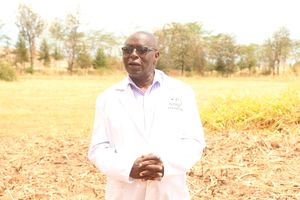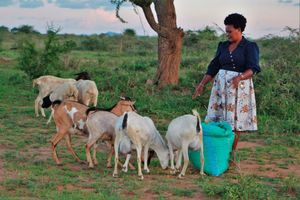The forgotten foods that can feed Kenya amid climate crisis

Healthy Nation has compiled a list of some of the traditional vegetables, tubers, cereals and even insects that Kenyans could tap into for better nutrition and health.
What you need to know:
- Besides their higher nutritional value, these food crops are more tolerant to changing and unpredictable weather patterns. They also grow in most parts of the country, unlike exotic crops such as maize and wheat which only grow in specific regions.
- Some parts of these crops are used as medicine, and some cost a pittance compared to other food varieties.
- Healthy Nation has compiled a list of some of the traditional vegetables, tubers, cereals and even insects that Kenyans could tap into for better nutrition and health.
Even as Kenya grapples with the challenge of food insecurity following six failed crop seasons, the country also boasts a diversity of indigenous food varieties.
For most Kenyans, food entails exotic vegetables and cereals. Collard greens, spinach and cabbage constitute the vegetable component of dishes in most Kenyan households.
But did you know that the country has more than 200 different species of indigenous vegetables?
Dr Patrick Maundu is a Kenyan ethnobotanist who has dedicated his entire life to research in the indigenous knowledge of African biodiversity in health and nutrition. He joined the National Museums of Kenya in 1989 and now heads the Kenya Resource Centre For Indigenous Knowledge (Kenrik).

Kenrik was established in 1992 to spearhead the work on Indigenous Food Plants Programme (IFPP), which was under East Africa Herbarium (EAH). The objective was to distribute information on edible wild plants collected for more than 90 years.
The institution now documents, preserves and disseminates indigenous knowledge on traditional food plants, traditional medicinal plants, sacred sites, eco- logical knowledge systems and building structures, says Dr Maundu.
The ethnobotanist believes in food diversification as an approach to boost household and community nutrition and security. He underscores the need to promote these varieties amid the current hunger crisis.
“It is unfortunate that we prioritised eating what our colonisers thought was better at the expense of what many generations before us ate. With the ongoing food shortages, we might have to go back to our roots. Indigenous foods are healthier. They kept our forefathers healthy and alive,” he argues.
Besides their higher nutritional value, Dr Maundu points out that these food crops are more tolerant to changing and unpredictable weather patterns. They also grow in most parts of the country, unlike exotic crops such as maize and wheat which only grow in specific regions.
Some parts of these crops are used as medicine, and some cost a pittance compared to other food varieties.
Healthy Nation has compiled a list of some of the traditional vegetables, tubers, cereals and even insects that Kenyans could tap into for better nutrition and health.
Cereals
Cereals are grains used for food and include wheat, maize and rye.
These are also cereals indigenous to Kenya and Africa.
Finger millet- Wimbi (Eleusine coracana)
Although it received less attention in the first Green Revolution, finger millet has both a rich nutrient profile and a climate resilience nature. Its seeds provide energy while its calcium content is much higher (almost 10-fold) than any other cereal crop. Additionally, it has better resistance to both biotic and abiotic stresses and a long shelf-life of seeds. . It is still an important crop in the Lake Victoria basin, West Pokot, parts of Baringo and Elgeyo Marakwet.

Also known as finger millet,Eleusine coracana has both a rich nutrient profile and a climate resilience nature.
Pearl millet- Mawele (Pennisetum glaucum)
Pearl millet is considered a staple food in Africa and India, where it is used to make flour for bread, porridge and other meals. Besides its tolerance to acidity in sandy soils, it can grow in saline soils as well. It is also hardier than maize and sorghum and grows where these cereals cannot grow because of drought. It is grown in the drier parts of eastern and coastal parts of Kenya.

Also known as pearl millet,Pennisetum glaucum is considered a staple food in Africa and India and is used to make flour, bread, porridge.
Sorghum bicolor (great millet)
Commonly known as sorghum, great millet is high in carbohydrates, with 10 per cent protein and 3.4 per cent fat content. It also contains calcium and small amounts of iron, vitamin B as well as niacin. The gluten-free grain is usually ground into a meal that is made into porridge, flatbreads and cakes. It’s found in Eastern and Coastal parts of Kenya.

Also known as great millet, Sorghum bicabor is high in carbohydrates, with 10 per cent protein and 3.4 per cent fat.
Pseudo-cereals
These are food crops that are non-grass in nature but are grown for their edible starchy seeds. They are grown for the same purpose as grassy crops.
Tsimboka (Amaranthus cruentus)
Tsimboka is a vegetable in the Luhya language. This variety is one of three Amaranthus species cultivated as a grain source. The fast-growing plant that is topped with clusters of dark pink flowers matures in between four and seven weeks. It can continue to produce for up to 250 days.
The seeds are cooked whole or ground into flour to make highly nutritious cakes. Besides the seeds, the leaves can be cooked as any other vegetable and are rich in vitamins A and C in addition to minerals such as iron and calcium. Found in Western, Eastern and Central region.

Amaranthus cruentus ,popularly known as ‘tsimboka’ in Luhya land, this is one of three Amaranthus species cultivated as a grain source.
Starchy fruits
Banana (Musa spp)
This is a nutritious fruit that grows from various large, herbaceous flowering plants from the genus Musa. Its flesh is soft, rich in starch and its skin (usually easy to peel) can either remain green or turn yellow, red, purple or brown when ripe.
Bananas contain high levels of minerals and phytochemicals (compounds produced by plants, generally to help them resist fungi, bacteria and plant virus infections) including flavonoids, which are beneficial for human nutrition.
Bananas grow in most parts of Kenya, including in counties in the Upper Eastern region, Central and Western Kenya.

Banana or Musa spp is a nutritious fruit that grows from various large, herbaceous flowering plants belonging to the genus Musa.
Pulse/Legume
Bambara Groundnut, Tsimbande (Vigna subterranean)
Dr Maundu argues that unlike other groundnut varieties in Africa, Bambara groundnuts are an ancient type of Uganda grain legume. The edible nutty part – which can be red, brown, cream or burgundy – is protected by a skin similar to that of peanuts. The seeds ripen underground for between three and four months. When the plants start to wilt, they are ready for harvesting.
Ripe or immature, raw or roasted, the seeds are highly rich in nutrients, including 60 per cent carbohydrate and 20 per cent protein content. These nuts also contain oil and other micronutrients. Notably, this protein food provides more methionine than any other legume.
The nuts are aired in the sun, then steamed or boiled until they are soft enough to eat. The pods can be used as fuel. Found mostly in Western and Central parts of Kenya.
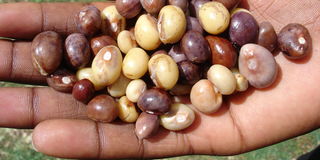
In Luhya land, Bambara groundnuts are popularly known as ‘tsimbande’. The edible part, the nut—which can be reddish, brownish, cream- coloured or burgundy—is protected by a skin similar to that of peanuts.
Cowpea- Kunde (Vignia unguiculata)
Owing to its tolerance for sandy soil and low rainfall, the cowpea is an important food crop in most semiarid regions of Africa. Typically, the crop is a climber and has trailing vines that bear edible compound leaves with three leaflets. The white, purple or pale-yellow flowers grow in pairs or in threes at the ends of long stalks. The pods are long and cylindrical and can grow for between 20 and 30 cm.
There are many ways to eat cowpeas. The leaves may be boiled or stir-fried, the green pods may be eaten fresh, steamed, stir-fried or sautéed. The dry seeds are often used in soups, stews, purees or ground into flour or fermented.
In terms of nutritional value cowpeas contain beta-carotene, vitamin E, riboflavin, folic acid, ascorbic acid, calcium, iron, protein while seed protein is relatively rich in lysine. Found in Western, Central, Eastern and parts of Northern Kenya.

The fruit of vignia unguiculata which also bears edible leaves.
Peanut- Njugu Karanga (Arachis hypogea)
The name hypogaea means ‘‘under the earth’’ since the pods containing the edible seeds grow below the ground. Peanuts thrive in warm climates with well-drained, light, sandy or loam soils.
The herbaceous perennial plant produces flowers above the ground but develops the fruit below ground in a process known as geocarpy.
Peanut seeds are edible and are high in protein and other minerals and vitamins. Roots, seed hulls or leaves are used for production of cosmetic products, among them soaps, plastics, wallboard, livestock feed, fertiliser filler and alternative fuels.
The peanut is the most common edible plant part and is consumed either raw or cooked. It is also made into oils, after removal of fats, and ground into flour. Young leaves and tips may be suitable as cooked green vegetables. They are found in Western, Eastern and Central parts of Kenya.

Peanuts thrive in warm climates with well-drained, light, sandy or loam soils.
Pigeon pea- Mbaazi (Cajanus cajan)
The pigeon pea is a woody shrub that reaches only about four centimetres high upon maturity. The plant has deep tap roots, which allow it to tolerate drought and poor soil conditions. The edible parts include the seeds, seedpods, leaves and young shoots.
Pigeon pea is also well known for its medicinal benefits with leaves used as treatment for coughs, bronchitis, diarrhoea, haemorrhages, sores, and wounds. Diabetes and sore throats can also be treated using other plant parts of pigeon pea.
The crop is widely grown in the tropics and subtropics. Found in Western and Coastal parts of Kenya.

The pigeon pea,popularly known as ' mbaazi' is a fruity woody shrub that reaches only about four centimetres high upon maturity.
Climbing bean- Ngelenge, Noe (Phaseolus lanatus)
This is a food crop grown mainly for its seeds and immature seed pods. There are different varieties of the plant that produce a wide range of beans, including the large, white or black ‘‘butter beans’’.
The mature seed is dried and stored for future use. A rich source of protein, noe require thorough cooking to be ready for eating. They can be eaten in a range of ways, including in soups and stews, boiled, fried or baked. Found in Eastern, Western and Central parts of Kenya.

Climbing beans can be eaten in a range of ways, including in soups and stews, boiled, fried or baked.
Roots and tubers
These are specialised storage stems of certain starchy seed plants that are typically short and thickened and usually grow below the soil.
Aerial yam (Dioscorea bulbifera)
This tuber crop is also known as ‘‘bitter yam’’ or ‘‘ritugu’’ in the Maragoli. It has aerial, potato-like tubers that grow at the leaf axils. The plant is often cultivated in tropical areas mainly for its edible aerial bulbs. The juice from its roots are used to treat threadworms. Found in Western Kenya.
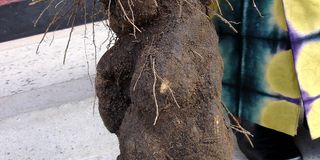
This tuber crop is also known as ‘‘bitter yam’’ or ‘‘ritugu’’ in the Maragoli.
Taro, Arrow root, Nduma (Colocasia esculenta)
Taro, also called the elephant ear, is a herbaceous plant that grows in marshy areas. Its tuberous root contains vitamin B, iron and phenolic components, according to Dr Maundu.
He adds that the tuber is easily digestible and is often used to prepare baby food. Young taro leaves and stems can be eaten after boiling and are a valuable source of fibre, calcium, phosphorus and vitamins A, B and vitamin C. Found in Central, Western and Coastal parts of Kenya.

Arrow Root or taro also called the elephant ear, is a herbaceous plant that grows in marshy area.
Cassava, Muhogo (Manihot esculenta)
This is a tuberous, starchy edible root. Cassava may be eaten raw or cooked. Some parts of the plant are highly toxic that could kill if eaten.
The cassava shrub may grow up to 2.75 m tall. This food plant is also medicinally used to treat hypertension, headache, and other pains, irritable bowel syndrome and fever.
According to the ethnobotanist, the cassava plant contains two different cyanogenic glucosides, linamarin and lotaustralin. Its fresh roots and leaves contain linamarin and hydrocyanic acid at levels that may be toxic. When properly treated through either roasting, soaking or fermentation, the cyanide content is negligible and largely harmless. Found in Western and Coast regions.

African eggplant, Mbilingani (Solanum macrocarpon)
This rare eggplant relative is known as ‘‘lisucha’’ among most Kenyans. All parts of the plant are useful, with its leaves cooked in vegetable soups in the same way as collard greens. The fruit is eaten when cooked with rice in many parts of Africa. Meanwhile, its root is used to treat bronchitis, itch, body aches and asthma. Its seeds treat toothache.
The juice from the vegetables is used in the treatment of gout, rheumatism and angina. In some communities, it is used as a traditional anesthesia during childbirth. Found in Western, Central and Coastal parts of Kenya.

African egg plant is known as ‘‘lisucha’’ among most Kenyans.
Slender leaf, Mitoo (Crotalaria brevidens)
The slender leaf is a food legume. Its young leaves and shoots are cooked as a vegetable in Kenya and Tanzania. It can be boiled or fried or used as a potherb in stews and soups.
In Africa, the slender leaf is mainly harvested as a vegetable by uprooting the whole plant. The uprooted thinnings may be used as a first harvest and the remaining plants are ready just before flowering after about eight weeks.
In Kenya the leaves are used to cure stomach-ache, swellings and even malaria. The roots are used to treat sore throats and mouth thrush. The shoots of the plant may be used as livestock fodder and seeds fed to poultry, discloses Dr Maundu.
A recent botanical use for the slender leaf is as an agent to promote the germination of Striga, a parasitic plant that is a major problem for maize and millet growers in Western Kenya. Found in Western, Central and Eastern parts of Kenya

The slender leaf , commonly known as 'mitoo' is a food legume.
Flying termites, Kumbe kumbe
Commonly known as ‘‘amatere’’ or ‘‘amatelle’’ in Western Kenya, these insects have been used for food for centuries. The male and female termites are rich in vitamins A and C. The worker termites, though, have the highest vitamin C content while Queen has the highest vitamin A content.
For centuries, insects have played an important role in human nutrition. It is believed that the first hominids in Africa were eating insects, including termites. They are a good source of protein with high fat content.
Termites are found in most parts of the country.
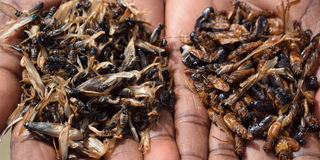
Flying termites have for centuries played an important role in human nutrition.
Termitomyces spp, Obwoba
These are seasonal fruit bodies of edible fungi and a genus of mushrooms whose seasonal edible fructifications are found exclusively in certain regions of Africa and Asia.
Termitomyces only grow in association with termites. Their nests are made of organic matter brought by the insects from feeding on trees.
According to Dr Maundu, the fungus helps the termites to degrade the plant-derived material such as wood, dry grass and leaf litter on which they live.
So far twenty edible species of termitomyces have been recorded from Africa and Asia. Found in Western Kenya as well as in semi-arid regions.
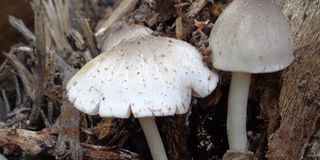
Termitomyces only grow in association with termites.
Conkerberry (Carissa spinarum)
Known as ‘‘ochuoga’’ in Luo Land and ‘‘matote’’ elsewhere in Kenya, this is a wild, spiny and evergreen shrub whose fruits are of commercial interest. The plant does well in hotter and drier tropics with deep, fertile soils. It can also thrive in dry, sandy and rocky soils according to the expert.
The red-black sweet fruit ripens to a blue-black colour. It is pleasant to eat raw or cooked in jams. Among communities where this shrub grows, the roots are often put in water gourds to give water a pleasant flavour.
They can also be added to soups and stews for flavour and to disguise the strong aroma of other foods. Found in Eastern Kenya.

Known as ‘‘ochuoga’’ in Luo land and ‘‘matote’’ elsewhere in Kenya, caeissa spiranum or conkerberry is a wild, spiny and evergreen shrub.
Leptadenia hastata, Ekamong’o
This is a climbing shrub that produces many soft stems that become woody at the base. Besides Kenya, it is also found in other tropical African countries such as Senegal, Ethiopia and Uganda.
Its fruits are cone-shaped fruits and release cottony winged seeds as they split open. The leaves, young shoots and sometimes flowers are cooked and added to soups.
Like many African indigenous plants, the ekamong’o is drought-tolerant and its sap has medicinal benefits. Found in Kenyan bushlands and low-lying seasonally flooded areas.
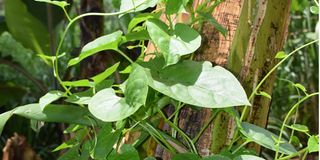
Like many African indigenous plants, ekamong’o is drought-tolerant and its sap has medicinal benefits.
Spider Plant, Sagaa (Gynandropsis gynandra)
In most Kenyan households, sagaa is a staple. This indigenous leafy vegetable is ranked the second most nutritious among the top four indigenous leafy vegetables consumed as relish. The others are pigweed (Amaranthus blitum), nightshade (Solanum scabrum) and cowpea (Vigna unguiculata).
It is recommended for pregnant and lactating mothers owing to its richness in proteins, vitamins, carbohydrates and minerals.
Moreover, sagaa has medicinal compounds that prevent cancer, asthma, diabetes and cardio-vascular diseases. The vegetable that is a source of edible oils and is used in manufacture of livestock feed can also be used as an insecticide. Found in Western, Central and Coastal parts of Kenya.

Popularly known as 'sagaa' or ' tsisakaa' , theb spider plant is an indigenous leafy vegetable that is ranked the second most nutritious among the top four indigenous leafy vegetables consumed as relish.

